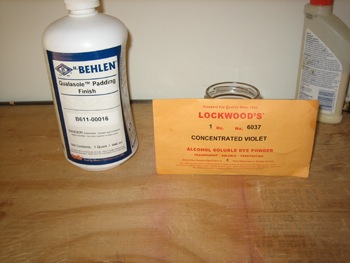
I'm working on a pair of sconces, and part of that work is picking a finish. First I chose a color and then a texture. I like purple, and I want the sconces to have a plasticky sheen.
Purple. Qualasole. Verdigris: A triangle of Saturation, Lustre and Opacity
I dyed some Qualasole, and put in on a piece of oak. It lacked something, so I made tamales.
Around the third or fourth day I ate tamales for lunch I offered one to Tim and handed him the Cholula.
Tim: Whats Masa?
Me: Limed Corn Meal. They soak corn in lye and then rinse it a lot.
Tim: Really? Lye can burn you.
Me: Yeah, crazy, huh? Is lye what's in those Liberon liming kits?
Tim: Umm, no. It's a wax and pigment.
Me: Oh, so no lye? I figured it was like bleach.
According to Google Image "Limed Wood" is code for "taupe-country-chic hell". So I asked Joel.
Me: Joel, what's liming?
Joel: You fill an open-grained wood with pigmented wax. It was used on art deco furniture. I did it with plaster once. You use a bronze brush. Or brass, but not steel. You want the bristles to be stiff enough to clear out the pores, but not too stiff, or they'll scratch. What you're trying to do open the grain so you can fill it with pigment. Try this pastrami, tell me what you think.
Me: So would it work on oak?
On our website a search for liming brings up Liberon specialty waxes. One of them is verdigris. I really like teal. Verdigris is teal. Tim says verdigris is copper oxidation. Oxidized pigments are usually opaque and thus perfect for getting a saturated teal limed effect over a saturated purple.
Mixed Drinks, Mixed Results: A Cryptic Record of Libation and Lime
I don't like to take notes, but when I'm trying out finishes I do it anyway and it's always worth the irk.
First I gathered supplies. My sconces will have exposed face, quarter, and end grain, so I made test blocks with sections of each. Since TFWW and I are out of denatured alcohol, I grabbed the Carnaby's gin, and a plastic pint of whiskey from the freezer.
Natured alcohol works really well with Lockwood dye. Besides its better odor and more delicious taste, gin and whiskey don't evaporate as quickly as pure ethyl and so the dye has a longer open time for color adjustment.
My mixed drink only worked out using forest green. With the alcohol based purple, padding on the Qualasole lifted too much color. I worked around this by adding dye to the Qualasole, and switching a to water based purple on the wood. This combination really works well because you get a more complex color when you put the alcohol-based purple over the slightly redder and more desaturated water-based purple.
It's really easy to apply verdigris over Qualasole. I think that part of the success of the technique comes from the Qualasole filling the very small pores of the wood, which keeps the verdigris liming confined to the larger pores of the grain structure. The effect is like looking at a black light, and I'm quite pleased with it.
|
 Joel's Blog
Joel's Blog Built-It Blog
Built-It Blog Video Roundup
Video Roundup Classes & Events
Classes & Events Work Magazine
Work Magazine



















Lime (calcium oxide or calcium hydroxide) and lye (sodium hydroxide) aren't the same thing at all. Look up "nixtamalization" in Wikipedia for the details on why the corn used for masa (field corn, not sweet corn) is treated with lime.
And I'm SO with you on the "natured" alcohol - it's preposterous that a perfectly safe and effective product (ethanol) has to be adulterated with something poisonous (methanol) just so we can use it to finish furniture without paying liquor taxes. My natured alcohol solvent of choice is Everclear. Sadly, there are only 10 states where it can be legally sold - lucky for me, I live in one of them and can buy it at the grocery store. :-)